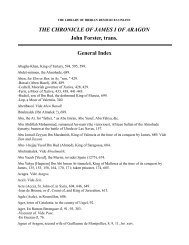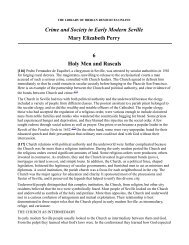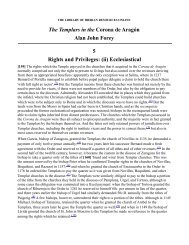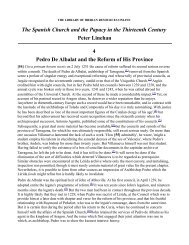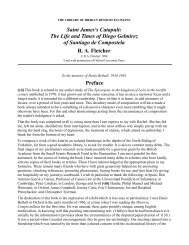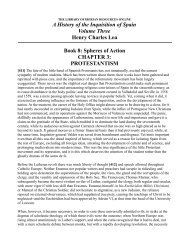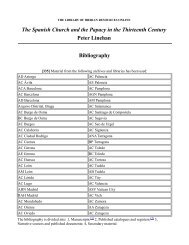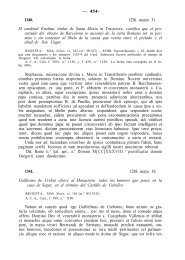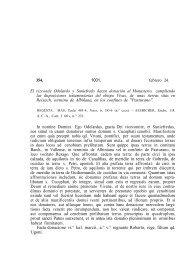Chapter 12 - The Library of Iberian Resources Online
Chapter 12 - The Library of Iberian Resources Online
Chapter 12 - The Library of Iberian Resources Online
You also want an ePaper? Increase the reach of your titles
YUMPU automatically turns print PDFs into web optimized ePapers that Google loves.
1959), pp. 18--19.<br />
57. "Molinería valenciana mijeval," pp. 702--704; the particle var, far, he explains, means watercourse.<br />
In reality Alfafara, which he thinks a related toponym, is an indisputable arabism meaning place where<br />
pottery is made (Asín Palacios, Toponimia árabe, p. 58).<br />
58. On Favara, "Repartimiento de Valencia," p. 269 (A.D. <strong>12</strong>40); Alfavara, ARV, Gobernación, 2241,<br />
9th hand, fol. 34r (Aug. 11, 1430): "los cequiers de muncada de alfavara e de les altres cequies."<br />
Compare the Magribi toponym El Faouar, "<strong>The</strong> Spring"; Pierre Moreau, Le pays des Nefzaouas (Tunis,<br />
1947), pl. 7, opp. p. 100).<br />
59. Rascanya: qanâ or qanâya, Arabic for "canal"; e.g., Pedro de Alcalá, p. 137, canná, pl. canaguát, as<br />
in canná quibura, "canal maestre" (apparently without the connotation <strong>of</strong> irrigation, in contradistinction<br />
to çáguia, pl. çaguiát, "regadura," p. 377). Rascayna: Repartimiento de Valencia, pp.154 (A.D. <strong>12</strong>37),<br />
266 (AD. <strong>12</strong>40). Rascanya is parallel to another common toponym, ras al-'ayn (fountainhead; Latin,<br />
caput aquae), as in Rasalany (Valencia; see Sanchis Guarner, Introducció, p. 90) and Ras-el-ain<br />
(Tunisia; see Moreau, Pays des Nefzaouas, pp. 141, 146).<br />
60. <strong>The</strong> canal and the district it waters frequently have the same name. Algirós (in Valencia and Alcira,<br />
both) is well documented. For Algorós see Ibarra y Ruiz, Riego de Elche, p. 255,<br />
61. Initial z into j is one <strong>of</strong> the few examples <strong>of</strong> this change (Steiger, Contribución, p. 145 n. 1). <strong>The</strong><br />
final b loses its sonority and changes first to f (e.g., Aljar<strong>of</strong>, the form in the Repartimiento de Valencia,<br />
p. 480; Steiger, Contribución, p. 110) and then to s. <strong>The</strong> commentators have ignored this toponym,<br />
concentrating on the Portuguese forms algeroz, algiroz, aljaroz, meaning gutter. See Eguílaz, Glosario,<br />
p. 180; also Dozy and Engelmann (Glossaire, p. <strong>12</strong>5), who remark that mizrâb was the current<br />
expression for gutter in North Africa and cite Freytag's definition <strong>of</strong> zarb as "canalis aquae."<br />
62. On Ador, Jaubert de Passa, Canales de riego, II, 165. On Zarahiche, i.e., zafariche to zahariche to<br />
zarahiche, by metathesis, Diaz Cassou, Ordenanzas y costumbres, p. 58.<br />
63. On Aljupet, Ibarra y Ruiz, Riego de Elche, p 209. Cisterns were important landmarks and gave rise<br />
to numerous toponyms. See ibid., p 10 (Port d'Aljup) and Asín Palacios, Toponimia árabe, p. 62, Algibe<br />
On El Albellon, Ibarra y Ruiz, Riego de Elche, p 295.<br />
64. On Calduf, Riegos de Alcoy: ordenanzas (Gandia, 1927), p. 2. Compare Asín Palacios, Toponimia<br />
árabe, p. ,51, Alcadoz<br />
65. On Tarqumn, Diaz Cassou, Ordenanzas y costumbres, p. 82.<br />
66. On El Azut, Archivo de la Corona de Aragon, reg. 64, fol <strong>12</strong>5v. On Burjassot. literally "the tower <strong>of</strong><br />
the dam," see Asín Palacios, Toponimia árabe, p. 98. <strong>The</strong> burj was not necessarily a defense tower but,<br />
like torre in modern usage, also meant a country house, cf. the toponym in Islamic Córdoba, Fahs al-<br />
Sudd, field <strong>of</strong> the dam (Torres Balbás, "Contornos de las ciudades hispanomusulmanas," pp. 453, 485).<br />
<strong>The</strong> burj <strong>of</strong> Burjassot may be that which gave its name to the Alborg Canal, which was apparently<br />
within the limits <strong>of</strong> the village <strong>of</strong> Burjassot (ARV, Gobernación, 2268, 4th hand, fol, 8r. May 1, 1442).<br />
<strong>The</strong> açut in question may in reality have been only a divisor or a permanent canal check, inasmuch as<br />
Burjassot is not located on the river.<br />
67. Asín Palacios, Toponimia árabe, p 111.<br />
68. Ibid., p. 103<br />
69. See Sanchis Guariler, Introducció, p. 90; Asín Palacios, Toponimia árabe, p. 94, Biar.<br />
70. Julian Ribera, "Influencias berberiscas en el Reino de Valencia," El archivo, 1 (1886-1887), 171.<br />
Compare the name <strong>of</strong> the Moroccan town Tetuan.




